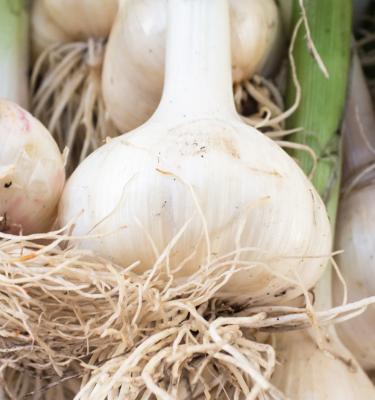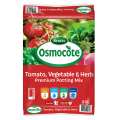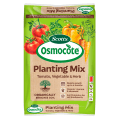

How to Grow Garlic in Australia
Growing garlic (Allium sativum) at home is now very popular. It's an easy vegetable to grow - just plant a garlic clove into the soil, wait a few months and you'll be rewarded with a bulb of up to a dozen or more cloves ready to use in the kitchen.
Garlic types
Garlic bulbs are divided into hardneck and softneck varieties. Hardneck garlic produce a flower spike, essentially a long stem growing up from the centre of the bulb and bearing a flowerhead. Softneck garlic doesn't produce a flower spike, so the 'neck' of the bulb stays soft and flexible.
Hardneck bulbs are hardier than softnecks and will grow better in areas with cold winters. The bulbs often have stronger, more complex flavours than softneck garlics. On the downside, the bulbs don't store as well as softnecks do.
Softneck garlics are best grown in areas with milder climates (temperate regions). The bulbs tend to have a mild flavour and can be stored for several months. Garlic bulbs sold in in greengrocers and supermarkets are usually softneck varieties.
There are quite literally hundreds of different varieties to choose from and there are a few Australian books on the topic too, if garlic is your passion.
Hardneck garlic varieties to try
- Monaco Purple
- Garlic Glamour
- Purple Stripe
- Porcelain
- Italian Purple
- Russian Red
Softneck garlic varieties to try
- Silverskin
- Turban
- Australian white
- Italian white
- Chinese Pink
- Creole
- Transylvanian
How to plant garlic
To grow garlic from a clove, begin by splitting the bulb carefully into individual clove segments, and then gently push each clove into the soil so the tip is just below the soil surface, with the pointed end of the clove upwards and the flatter basal plate facing down. Allow a gap of 15cm between each clove and 20-30cm between rows.
Watch our helpful video below to learn more about how to grow and harvest garlic in 7 simple steps.
Garlic growing equipment list
To grow garlic in your garden you will need:
- Spade
- Fork
- Garlic bulbs
- Compost and soil improver or well weathered manure
- Vegetable fertiliser
6 steps to plant your first garlic

Garlic does best in a fertile, well-drained soil in a position that receives full sun for most of the day. The bulbs need a period of cold weather in order to initiate growth, so the best time to plant garlic is in autumn, although there are some varieties that have been bred for spring planting.
- Before planting garlic, prepare the soil by digging in plenty of compost or manure. If your soil is very heavy clay, add some coarse washed river sand or plant bulbs in containers instead.
- Remove any weeds.
- Apply a vegetable fertiliser according to the label instructions, and rake in.
- Break the garlic bulbs into individual cloves.
- Plant the garlic cloves 15cm apart and with the tip just below the surface and pointing upwards. Space rows 30cm apart.
- Water after planting the garlic, to help settle the soil around the cloves.
How to grow garlic in pots
When it comes to growing Garlic in pots, garlic will grow happily in containers or pots outdoors. Growing garlic in pots is a good option in gardens where the soil is very heavy and wet.
- Choose a container at least 30cm in diameter and 20cm deep, with good drainage holes.
- Fill with a good quality multipurpose compost and add a controlled release vegetable fertiliser.
- Plant the cloves 10-15cm apart and 2.5cm deep, with tips just below the surface and pointing upwards. Don't plant bulbs right up against the edge of the container - leave enough space for them to swell as they grow.
- Water regularly to keep the compost moist.
Caring for garlic
Once planted, garlic doesn't need much looking after. Just follow these simple steps for a good crop:
- Keep beds weed-free. Remove weeds by hand to avoid damaging the bulbs with a hoe.
- Water during long dry periods.
- Stop watering once the leaves start turning yellow and the bulbs start to swell.
- On hardneck bulbs, pick any developing flower heads (scapes) before flowers open, to keep the plant's energy focused on developing the bulb. The scapes are edible and very tasty!
Harvesting garlic

While garlic is growing, you can harvest a leaf now and then to add to salads, but don't take too many at a time from any one plant.
Scapes should be picked before the flowers develop. The scapes have a mild garlic flavour and can be cooked or chopped up and added raw to salads.
The garlic bulbs themselves should be ready to harvest from early summer. To know when to harvest garlic, look at the plants' leaves - when they turn yellow, the garlic is ready to be harvested.
Use a garden fork to gently lift the bulbs from the soil.
Simply upend pots to harvest garlic grown in containers.
How to store garlic
- Before storing garlic, lay the bulbs outside in the sun on a rack, or inside in a well-ventilated shed, to allow them to dry out. This will take two to three weeks.
- Once the skins are dry and papery, the bulbs are ready to be stored. Remove any damaged or bruised bulbs.
- Store garlic bulbs in a string bag or plait the leaves and hang them in a cool, dry, dark place.
Common garlic pests & diseases
Although garlic is easy to grow, there are a few diseases that can cause problems, including:
White Rot
White rot is a fungal disease that rots garlic bulbs and causes leaves to turn yellow and die. Unfortunately, there's no treatment available for this. Burn all affected plants and don't plant garlic or other allium bulbs in that soil for at least eight years.
Leek Rust
Leek rust, another fungal disease, causes orange blotches on leaves. Mild cases will not necessarily affect the crop but remove any infected leaves as soon as you see them and burn or dispose of them (but not into the compost). Leek rust is more common in long periods of wet weather and on overcrowded plants. Avoid planting garlic or other alliums in affected soil for at least three years.
Aphids
Aphids are little bugs about 2mm long, and you’ll often see clusters of them feeding at the growing tip of young plants. They feed by sucking the sap of plants – this weakens the plant and reduces its growth. Leaves can become curled or distorted in shape.
Whether you’re growing veggies in your garden or caring for your plants, you can head to our advice and inspiration section for more helpful gardening guides. And remember to sign up to our newsletter for all your essential tips and tricks – plus special offers, promotions and competitions – delivered right to your inbox.
FAQs
How to grow garlic bulbs?
To grow garlic bulbs in Australia, choose a sunny spot with well-drained soil. Plant garlic cloves 5-10 cm deep in autumn (March-May) for optimal growth. Space the cloves roughly 15cm apart. Water regularly but avoid over-watering.




